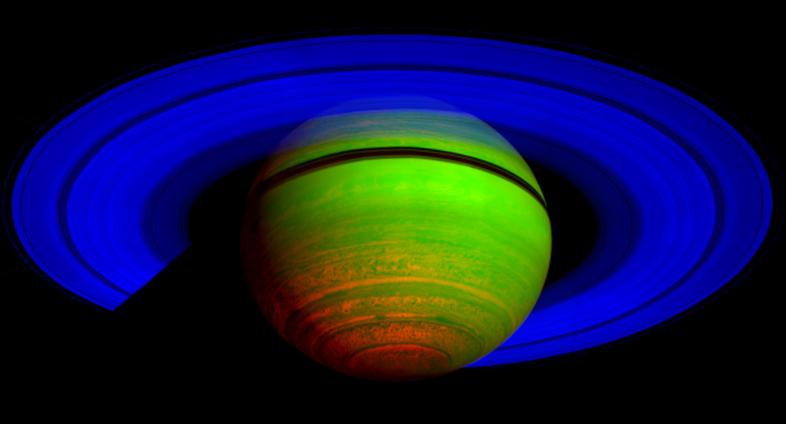That Saturn actually emits more than twice the energy it absorbs from the sun has been a science puzzle for decades but long-term data from the composite infrared spectrometer (CIRS), when combined with information about the energy coming to Saturn from the sun, could help scientists understand the nature of Saturn's internal heat source.
The planets in our solar system lose energy in the form of heat radiation in wavelengths that are invisible to the human eye. The CIRS instrument picks up wavelengths in the thermal infrared region, far enough beyond red light where the wavelengths correspond to heat emission.
"In planetary science, we tend to think of planets as losing power evenly in all directions and at a steady rate," said Liming Li of the University of Houston. "Now we know Saturn is not doing that."
Instead, Saturn's flow of outgoing energy was lopsided, with its southern hemisphere giving off about one-sixth more energy than the northern one, Li explains. This effect matched Saturn's seasons: during those five Earth-years, it was summer in the southern hemisphere and winter in the northern one. A season on Saturn lasts about seven Earth-years.
Like Earth, Saturn has these seasons because the planet is tilted on its axis, so one hemisphere receives more energy from the sun and experiences summer, while the other receives less energy and is shrouded in winter. Saturn's equinox, when the sun was directly over the equator, occurred in August 2009.
In the new study, Saturn's seasons looked Earth-like in another way: in each hemisphere, its effective temperature, which characterizes its thermal emission to space, started to warm up or cool down as a change of season approached. The effective temperature provides a simple way to track the response of Saturn's atmosphere to the seasonal changes, which is complicated because Saturn's weather is variable and the atmosphere tends to retain heat. Cassini's observations revealed that the effective temperature in the northern hemisphere gradually dropped from 2005 to 2008 and started to warm up again by 2009. In the southern hemisphere, the effective temperature cooled from 2005 to 2009.

False-color composite image, constructed from data obtained by NASA's Cassini spacecraft, shows Saturn's rings and southern hemisphere. The composite image was made from 65 individual observations by Cassini's visual and infrared mapping spectrometer in the near-infrared portion of the light spectrum on Nov. 1, 2008. The observations were each six minutes long. In this image constructed from data collected in the near-infrared wavelengths of light, scientists designated blue to indicate sunlight reflected at a wavelength of 2 microns, green to indicate sunlight reflected at 3 microns and red to indicate thermal emission at 5 microns. Saturn's rings reflect sunlight at 2 microns, but not at 3 and 5 microns, so they appear deep blue. Saturn's high altitude haze reflects sunlight at both 2 and 3 microns, but not at 5 microns, and so it appears green to blue-green. The heat emission from the interior of Saturn is only seen at 5 microns wavelength in the spectrometer data, and thus appears red. The dark spots and banded features in the image are clouds and small storms that outline the deeper weather systems and circulation patterns of the planet. They are illuminated from underneath by Saturn's thermal emission, and thus appear in silhouette. Credit: NASA/JPL/ASI/University of Arizona
The emitted energy for each hemisphere rose and fell along with the effective temperature. Even so, during this five-year period, the planet as a whole seemed to be slowly cooling down and emitting less energy.
To find out if similar changes were happening one Saturn-year ago, the researchers looked at data collected by the Voyager spacecraft in 1980 and 1981 and did not see the imbalance between the southern and northern hemispheres. Instead, the two regions were much more consistent with each other.
Why wouldn't Voyager have seen the same summer-versus-winter difference between the two hemispheres? One explanation is that cloud patterns at depth could have fluctuated, blocking and scattering infrared light differently.
"It's reasonable to think that the changes in Saturn's emitted power are related to cloud cover," says Amy Simon-Miller, who heads the Planetary Systems Laboratory at Goddard and is a co-author of the paper. "As the amount of cloud cover changes, the amount of radiation escaping into space also changes. This might vary during a single season and from one Saturn-year to another. But to fully understand what is happening on Saturn, we will need the other half of the picture: the amount of power being absorbed by the planet."
Scientists will be doing that as a next step by comparing the instrument's findings to data obtained by Cassini's imaging cameras and infrared mapping spectrometer instrument. The spectrometer, in particular, measures the amount of sunlight reflected by Saturn. Because scientists know the total amount of solar energy delivered to Saturn, they can derive the amount of sunlight absorbed by the planet and discern how much heat the planet itself is emitting. These calculations help scientists tackle what the actual source of that warming might be and whether it changes.
Better understanding Saturn's internal heat flow "will significantly deepen our understanding of the weather, internal structure and evolution of Saturn and the other giant planets," Li said.
Citation: Li, L., B. J. Conrath, P. J. Gierasch, R. K. Achterberg, C. A. Nixon, A. A. Simon-Miller, F. M. Flasar, D. Banfield, K. H. Baines, R. A. West, A. P. Ingersoll, A. R. Vasavada, A. D. Del Genio, C. C. Porco, A. A. Mamoutkine, M. E. Segura, G. L. Bjoraker, G. S. Orton, L. N. Fletcher, P. G. J. Irwin, and P. L. Read, 'Saturn's emitted power', J. Geophys. Res., 115, E11002, doi:10.1029/2010JE003631






Comments